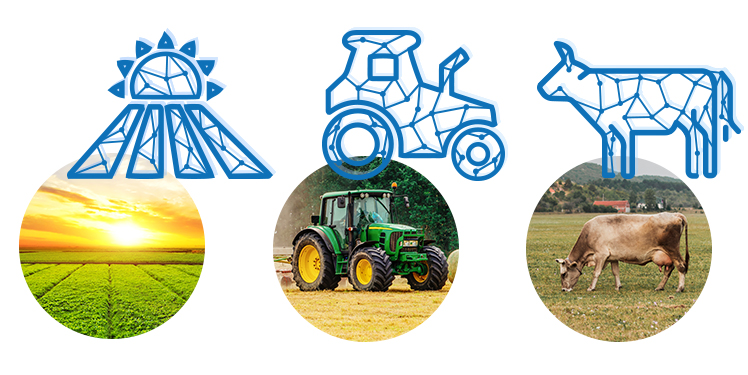Digital Twins as a new solution for agriculture: In digital agriculture, the across-the-board exchange of data and services is still a major problem. We therefore propose placing a fundamentally new concept over existing data standards and formats, without abolishing these: Digital Twins make this possible.
To this end, we present elementary concepts in this article and discuss their advantages and a possible realization within the context of digital agriculture.
What are Digital Twins?
Digital Twins are virtual images of assets from the real world, both physical and non-physical ones. Not only products, machines, or complete production plants can be represented as Digital Twins, but also processes and services. At the same time, there is not a single, generally valid definition of a Digital Twin, but rather there are small and large differences depending on the concrete environment and also on the industry. What is typical for Digital Twins, however, is the bidirectional exchange of data between the real world and the virtual representation. If, for example, the real asset changes, this change should be mirrored and represented in the Digital Twin. Conversely, a work instruction executed on the Digital Twin can be implemented as a concrete work step in the real world. A special type in this context is the Digital Shadow, which “only” provides for a flow of data from the real world to the virtual representation and thus offers a mapping of the real world to the virtual world.
In production engineering, Digital Twins have long been a familiar concept. They are part of the concepts of the Platform Industrie 4.0. Beyond being used to control individual production processes, they are seen as a solution for the overarching exchange of information in ecosystems between manufacturers, suppliers, and customers.
Digital Twins for Agriculture
Even though agriculture with its business and work processes cannot be compared one-to-one with the environment of production industries, it is still worth examining concepts that are established there, such as Digital Twins, for their applicability in agriculture. In principle, Digital Twins are conceivable for a wide range of industrial and production assets: from the virtual representation of a single plant or a dairy cow to the field or the stable, from the digital representation of an environmental sensor via that of an agricultural machine to the entire farm as an “agricultural production facility”.
In the context of the Fraunhofer lighthouse project Cognitive Agriculture (COGNAC), we are investigating, among other things, possible applications of Digital Twins in agricultural production. Using the example of the “Digital Field Twin”, we want to discuss the question whether Digital Twins in agriculture can fulfill similar expectations as in Industrie 4.0. Specifically, we are interested in Digital Twins as a possible solution concept for improved interoperability, safety, and future viability of digital offerings.
The Digital Field Twin
If we consider a field plot as a possible application area for Digital Twins, we could envision this scenario as follows: The Digital Field Twin brings together all information sources regarding the real field. These include, among others, work processes recorded by machines, information transmitted from software solutions, data captured live by sensors, etc. This information is stored in the Field Twin and can be used by applications and farmers. On the one hand, the Digital Field Twin stores information and can thus offer a history of data; on the other hand, it also provides an interface for access to current sensor data such as satellite images or weather data. In this scenario, the Field Twin is intended as a central component representing a field plot, which can be used by any actors or persons – provided this is permitted by the owner, resp, the leaseholder of the plot. For example, a Farm Management Information System (FMIS) could access data from the Field Twin to complement its own data storage, or might even completely dispense with its own storage.
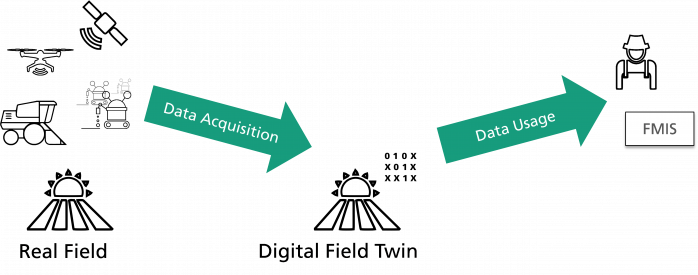
In addition to the mere provision of data, there is great potential in offering extended query options or smart services based on the data in the Field Twin. Such services could, for example, bundle frequent requests or provide forecasts based on simulations; i.e., the Field Twin also offers services itself.
More than a digital shadow
Up to now, the scenario described above overlaps to a large extent with the concept of a Digital Shadow, since it is primarily data that is merged and offered for use. However, the reverse flow of information is also conceivable. One example is the triggering of field work or even just field analyses via the Digital Field Twin. For example, a farmer could trigger an order in the FMIS to compile all currently available status values about a field plot in the Field Twin, which is then executed by a service assigned to the Field Twin and stores all available data in the history with the current time stamp.
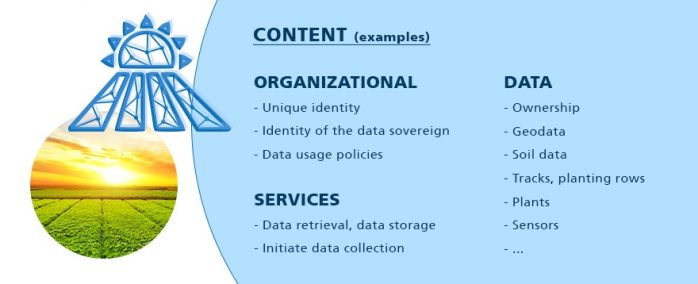
In the following, we list some core elements of Digital Twins that can also be implemented for Digital Field Twins:
- Unique digital representation: A Digital Field Twin describes a concrete field plot with all the information required for agricultural or downstream processes. Like its real representation, a Digital Field Twin exists only once.
- Merging of several diverse data sources: Not only historical statuses are stored and offered (“digital product memory”), but also current sensor values for the field plot.
- Centralized access via a data platform: In order to enable a comprehensive exchange of information in the Digital Ecosystem, a Digital Field Twin can be offered via a digital data platform. This makes it possible to realize centralized access to information that can be used without discrimination and can also be integrated into external services.
- Interoperability between systems: The introduced across-the-board availability of Digital Twins in the Digital Ecosystem is a central enabler for interoperability between systems. In addition, technologies and concepts such as triple-store storage, vocabularies, and ontologies enable interoperability even between different standards. Directory services serve to flexibly query and use information content and scope.
- Extensibility: Data storage and interfaces of Digital Twins can be designed in a flexible and extensible manner using the above-mentioned technologies. This makes the concept future-proof.
- Composition: Digital Twins can themselves be composed of or contain several Digital Twins. This can also happen dynamically. For instance, several Digital Field Twins can be combined to form larger areas of cultivation, or they may also contain Digital Twins of sensors or plants.
- Data sovereignty: A security network can be integrated into Digital Field Twins that offers different levels of data protection and data sovereignty for owners or authorized users of the real field plot. The goal is, on the one hand, full control and transparency of data usage by third parties, but, on the other hand, also the promotion of data exchange. Data usage that is fair for all stakeholders promotes the willingness to share data and thus also fosters the data economy.
- Cognitive functions for innovative processes: Beyond offering information, the Digital Field Twin also offers algorithms for describing the real world. This enables, for example, smart aggregation of data, but also What-If simulations and forecasts about the future developments of the field plot.
Field Twins in the digital domain ecosystem “Agriculture”
In the Fraunhofer lighthouse project COGNAC, we are studying the digital domain ecosystem “Agriculture” and are developing concepts for an Agricultural Data Space (ADS). The ADS creates the basis for Digital Ecosystems along the entire agricultural value chain and can be connected via a digital platform, the ADS Platform. The data space includes farmers with their farms, machinery, and digital applications; service providers with agricultural or digital offers; manufacturers of agricultural machines or means of production with their own data platforms; as well as retailers and end customers. In a living Digital Ecosystem, these participants can use data among each other and offer mutual services based on this data.
For Digital Twins such as the Field Twin, the question now arises how to use them in the data space. There are already many use cases in the ecosystem that require across-the-board exchange of information and constant digitalization of agriculture. In addition, the increasing importance of the data economy also demonstrates the clear trend towards further expansion of such use cases. Digital Twins can provide the capabilities that support such use cases or even make them possible in the first place.
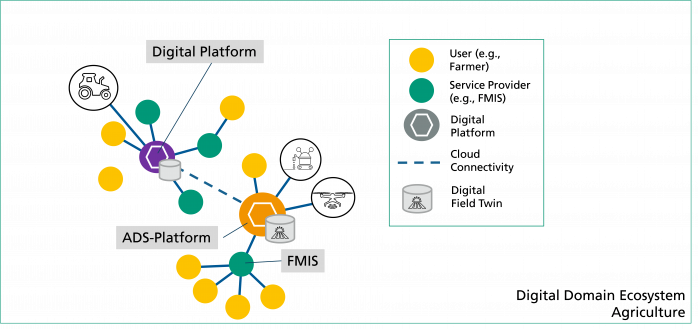
When it comes to the question of how such Digital Twins are specifically designed, provided, and offered to the ADS, several possibilities exist. One possibility is the implementation in the context of a central data platform such as the ADS Platform. The ADS Platform offers the Field Twin via open interfaces for use in the ecosystem. At the same time, however, it also ensures that the data sovereignty of farmers or other, basically arbitrary roles with legitimate rights to data is respected. In this way, an FMIS could use data in a Field Twin without having to store such data itself.
The ADS platform as a neutral platform for interoperability and data sovereignty
In our current concept, the ADS Platform is a neutral service for the provision of services for the storage and provision of Digital Twins, which, however, does not have its own FMIS business models. This also means that data in the Field Twin can only be used to a limited extent on the ADS Platform. Yet it offers comprehensive functionality for enforcing data sovereignty: A dashboard for data sovereignty allows detailed settings to control access rights to data in Field Twins and makes transparent which data may be used, and has been used, by whom.
Use cases for a safe and interoperable Digital Ecosystem
The above-mentioned key points of Digital Twins in agriculture and the Digital Field Twin in particular already represent a scope of functions that goes far beyond mere data storage. In the following examples, we outline basic and more specific possible applications for Field Twins:
- By decoupling data storage and individual systems – such as different FMIS or machine platforms – data about one field plot flows into one central and unique component. In this way, data is available in one place and not fragmented and distributed across several systems. Vice versa, it is possible for all these systems to use a Field Twin as a complementary or standalone common data basis.
- Open and generic interfaces allow Field Twins to be used by any software solution. If, for example, Field Twins can access existing sensors in the field, their data can be retrieved via these interfaces, without the need to understand or control these specific sensors. This independence also makes it possible to exchange sensors or any other devices without having to change applications accessing them.
- New, innovative applications can be implemented easily and efficiently by having them access the existing data infrastructure in the form of the Field Twins. This makes it easier for start-ups, for example, to enter the market and promotes innovation in agriculture.
- Plant cultivation consultants can call up current sensor values just as easily as historical application and harvest data and can thus create recommendations with great precision and based on solid data.
- Farmers can plan their work processes more easily and accurately by having cognitive functions in the Field Twins link information and algorithms. This makes it possible, for example, for forecasting models fed with current and historical data to predict optimal harvest times, including ripeness and weather forecasts for possible harvest days.
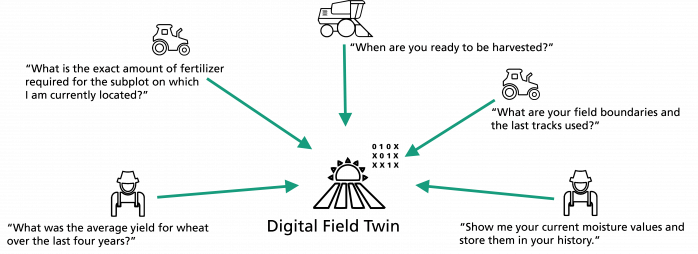
Opportunities for Digital Twins in Agriculture
In addition to the consolidated, interoperable provision of data by Digital Twins such as the Field Twin, there is enormous potential especially in the cognitive functions to simplify processes in agriculture and be able to offer digital support with pinpoint accuracy. The possible applications and functions of Digital Twins are practically unlimited for agriculture. Digital Twins must be designed to be open and flexible in order to keep pace with the dynamic developments in the course of the digitalization of agriculture. This is supported by integrated concepts such as directory services and vocabulary services.
A concrete realization is technically challenging and will put the agricultural domain to the test, as familiar processes and architectures need to be adapted. Modern technologies, however, provide a tool kit with which the technical implementation can become a success. One advantage is that systems can be integrated into an overarching data space gradually, flexibly, and at their own pace. Although a Field Twin only unfolds its full capabilities when everyone participates, this gradual integration will not overwhelm the digital agriculture.
In the future, the concept of the Digital Twins can be expanded beyond the Field Twin, and additional entities can be included in order to support agricultural enterprises as well as upstream and downstream companies in the way their respective processes require. With a view to Industrie 4.0, Digital Twins can thus make a tangible contribution to the effective digitalization of agriculture.

